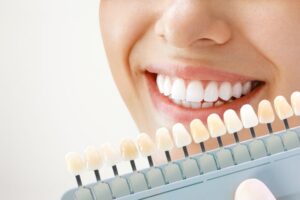
Are you disappointed or concerned because your smile seems to have lost its luster? Perhaps it looks a little yellow, gray, or simply dull. Understanding the types of tooth stains and how to address them can help you achieve the bright smile you desire! This blog post explores intrinsic, extrinsic, and age-related tooth stains, and it offers advice on teeth whitening options.
Types of Tooth Stains
There are three main types of tooth stains:
Extrinsic stains are found on the surface of teeth. These stains result from consuming foods and beverages like coffee, tea, red wine, and berries. Tobacco use can also cause them. Good oral hygiene and regular dental cleanings can help minimize the occurrence of new extrinsic stains.
Intrinsic stains occur inside the tooth. These stains are often caused by factors such as certain medications, trauma, or excessive fluoride exposure during childhood. Intrinsic stains are more challenging to remove because they are embedded within the tooth structure.
Age-related stains stem from a combination of intrinsic and extrinsic factors. As the years and decades pass, the outer layer of enamel on your teeth can wear away, revealing the yellowish dentin underneath. Additionally, the cumulative effect of extrinsic stains over the years can contribute to age-related discoloration.
Teeth Whitening Options
There are several teeth whitening options available to help you achieve a brighter smile:
- Over-the-counter whitening products: Products such as whitening toothpastes, strips, and gels can help reduce surface stains. These options are convenient and affordable, but they may not be as effective for deeper stains.
- Professional whitening treatments: Visiting a dentist for professional whitening treatments can yield more significant results than OTC products. Dentists use stronger whitening agents and advanced techniques to address both intrinsic and extrinsic stains. You may qualify for either an in-office treatment or custom take-home whitening kit.
- Veneers or bonding: These methods do not actually whiten teeth. Rather, they can effectively hide discoloration, so they can be an excellent option for severe stains. Plus, veneers have a nonporous nature that does not absorb pigments, so you can expect them to stay bright and beautiful for many years.
Regardless of the type of tooth stains that are affecting your smile, you may be able to brighten your teeth with the help of your dentist! Talk to them to learn about your options for achieving a brighter and more confident grin.
Meet the Practice
At Santavicca Dental Professionals, our friendly team offers in-office whitening, take-home whitening kits, veneers, and other cosmetic treatments that can help patients achieve brighter smiles. If you are concerned about dental stains, we are ready to evaluate your case and recommend your next steps. Get in touch with our Lebanon, NH, office at 603-215-7108.
